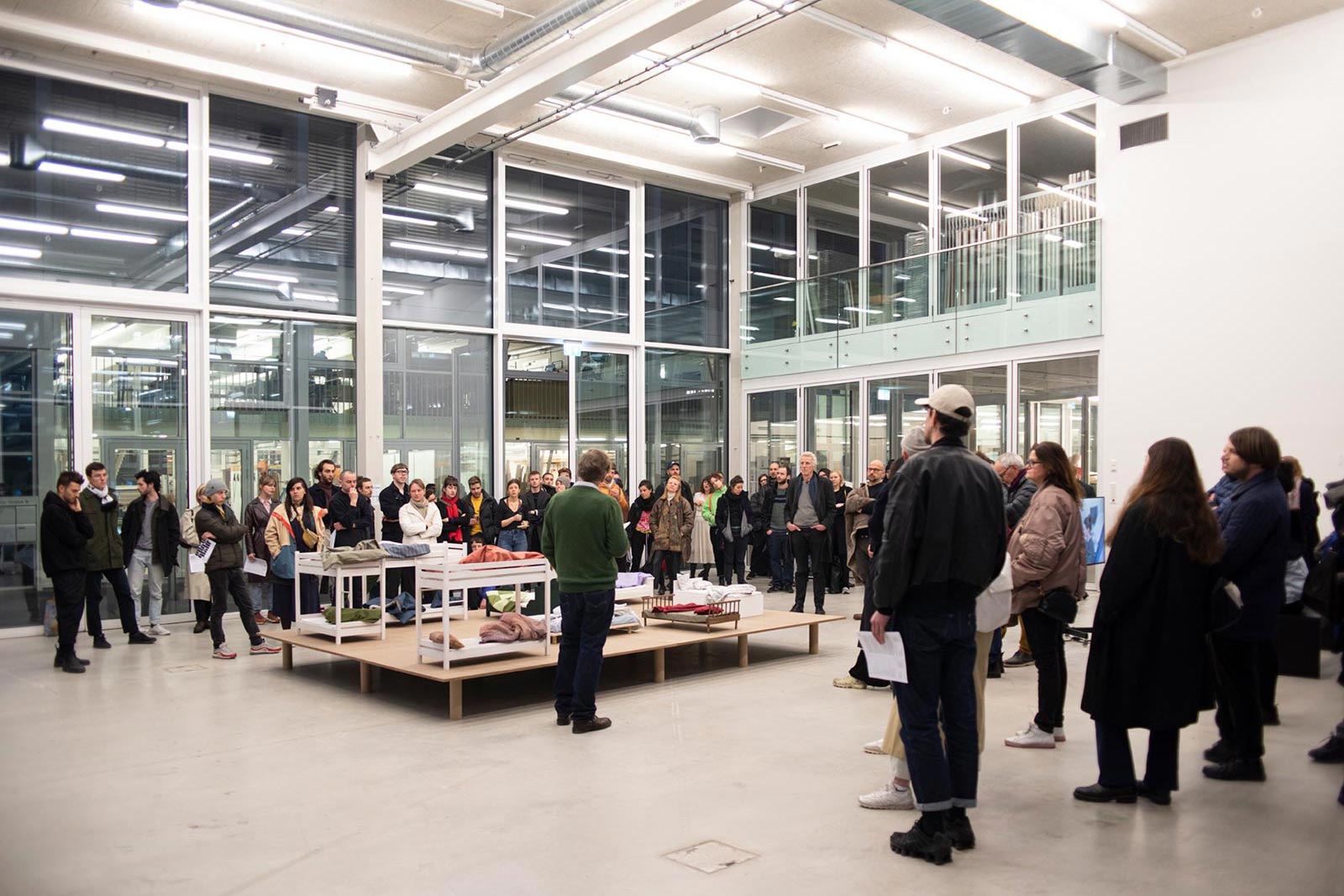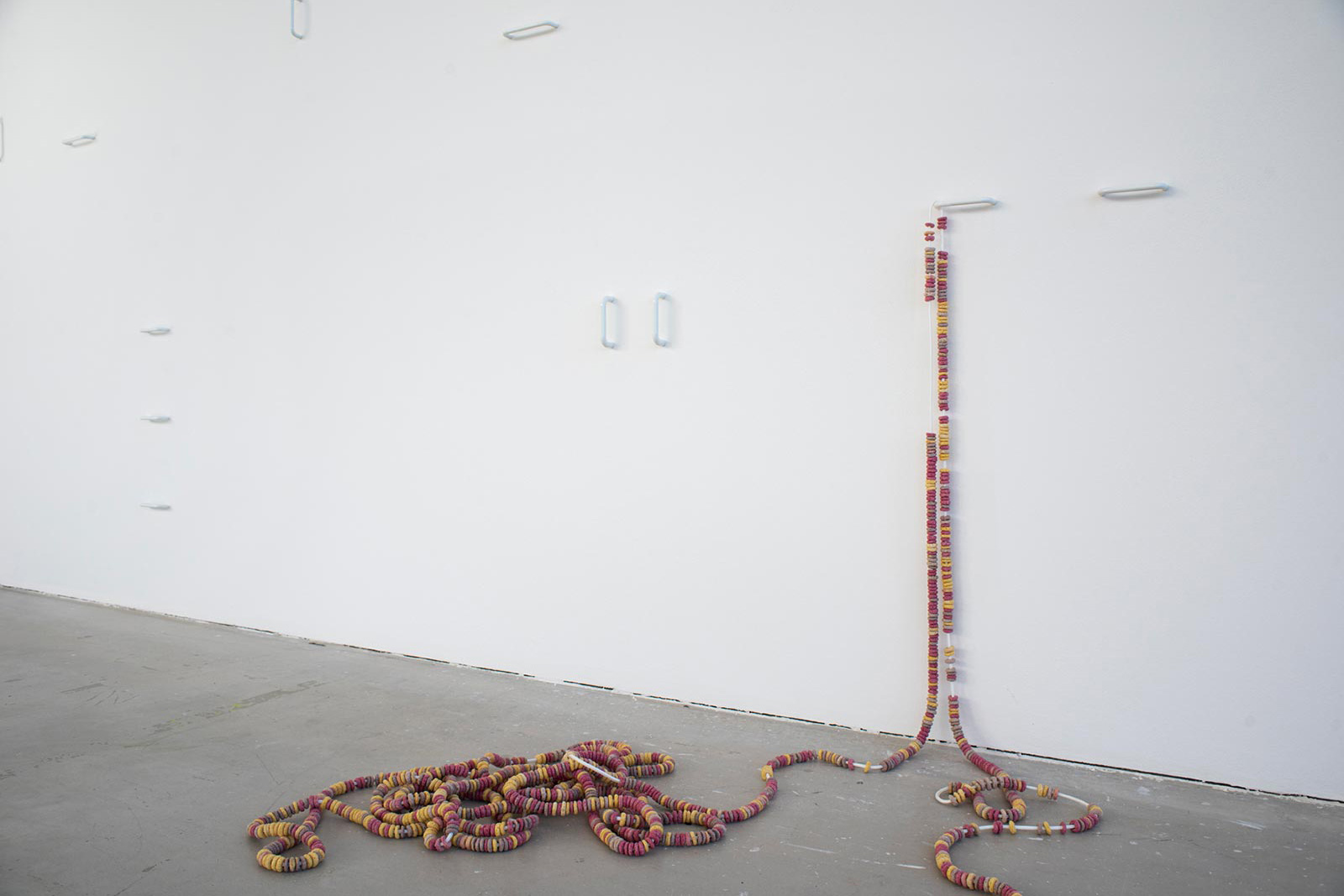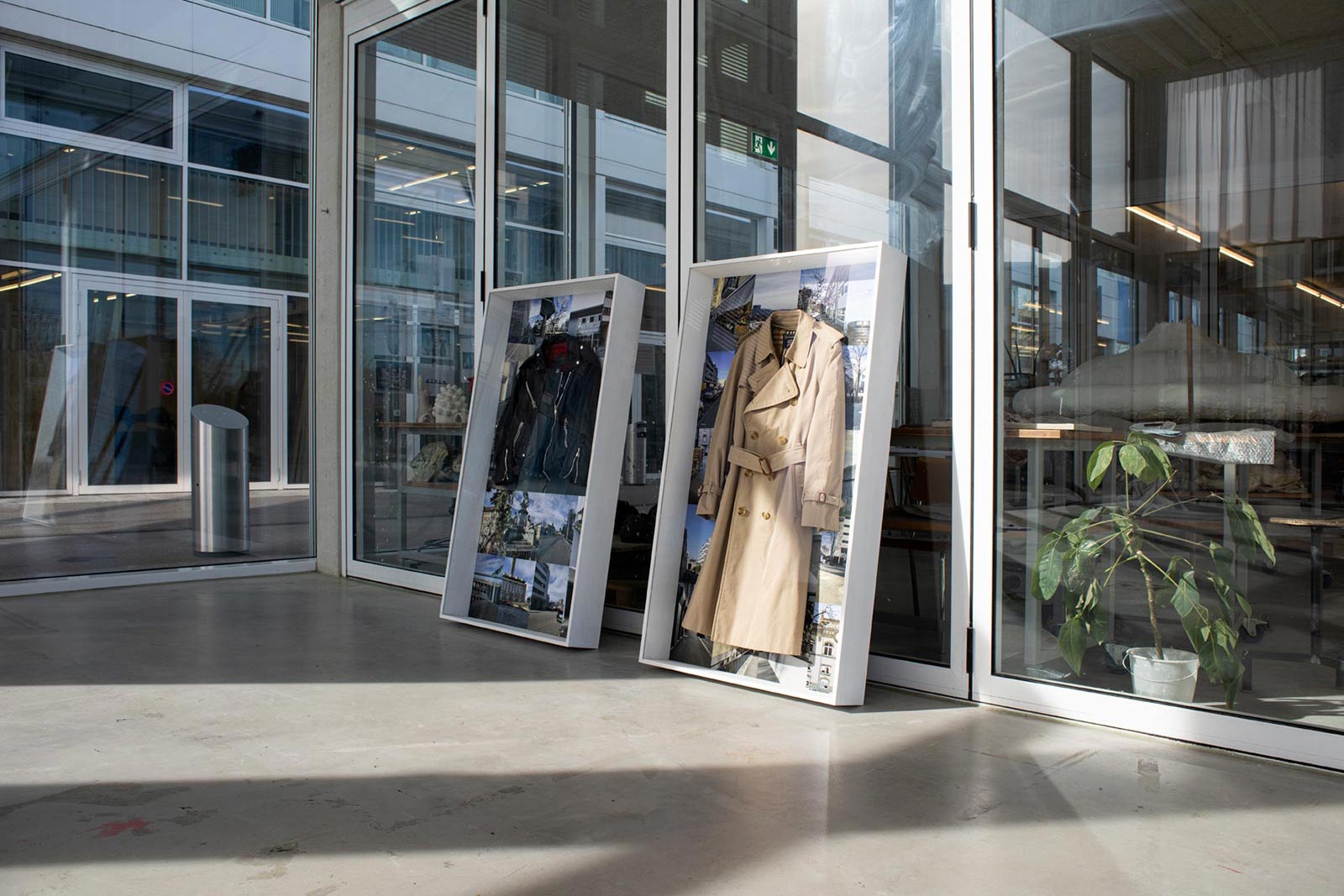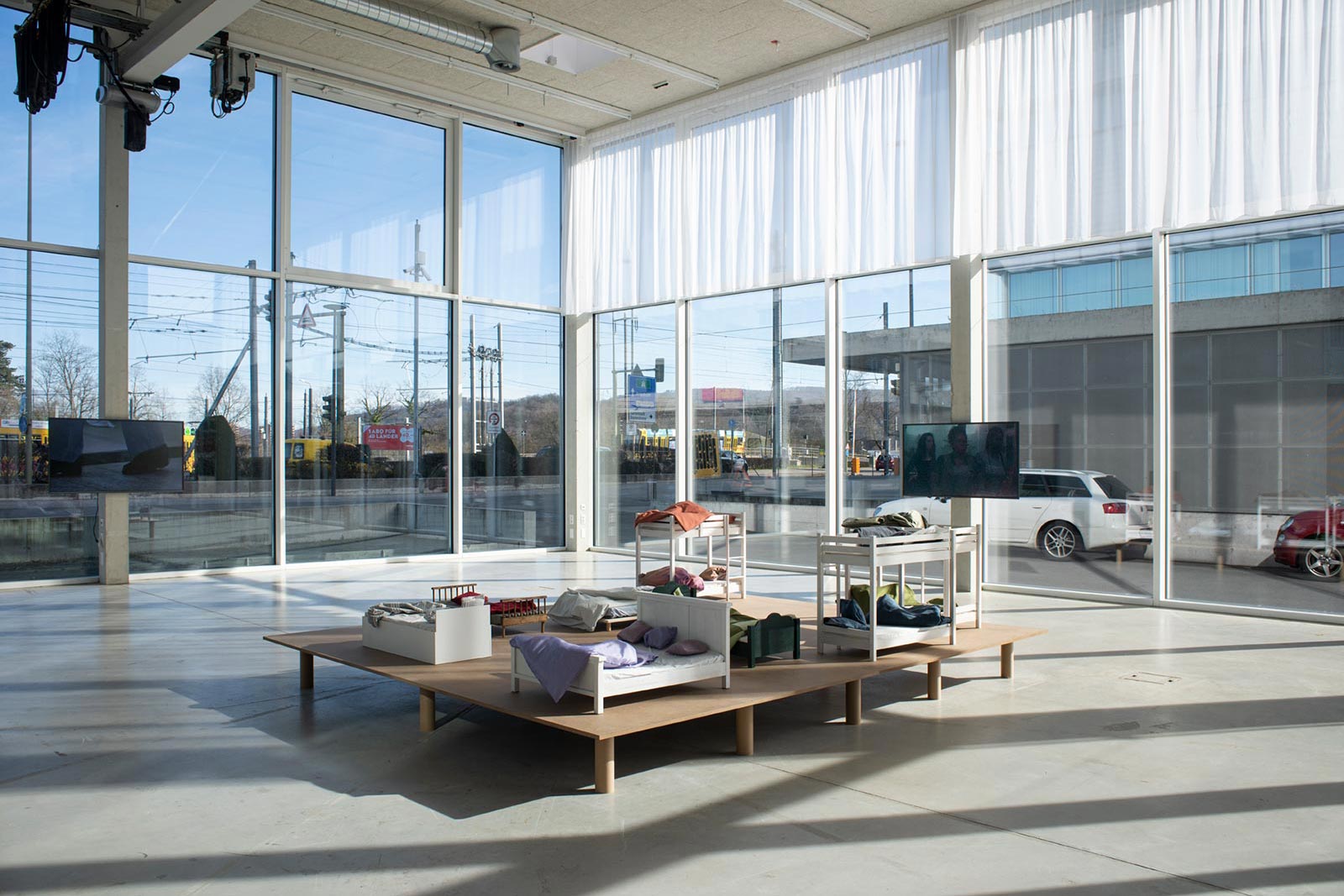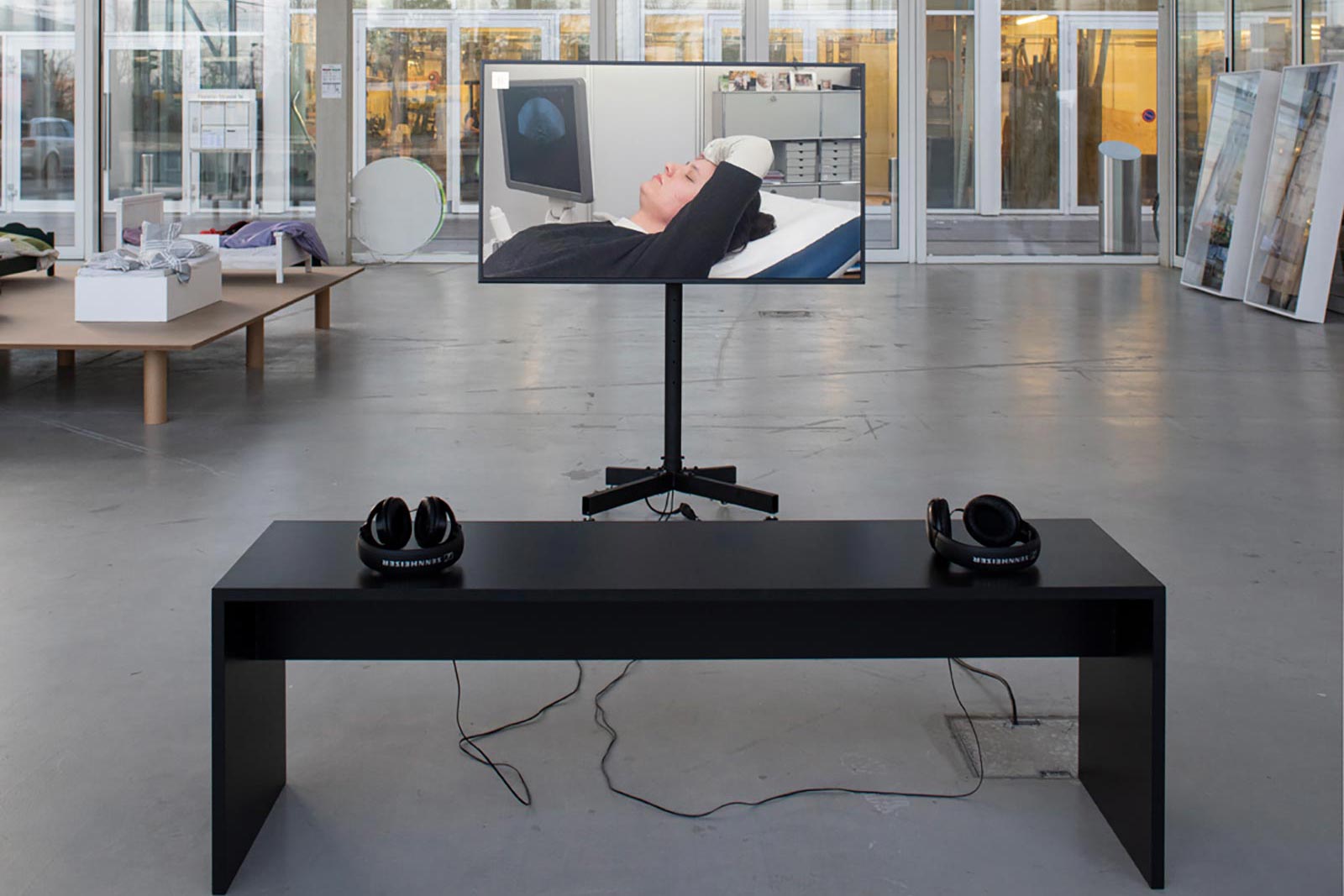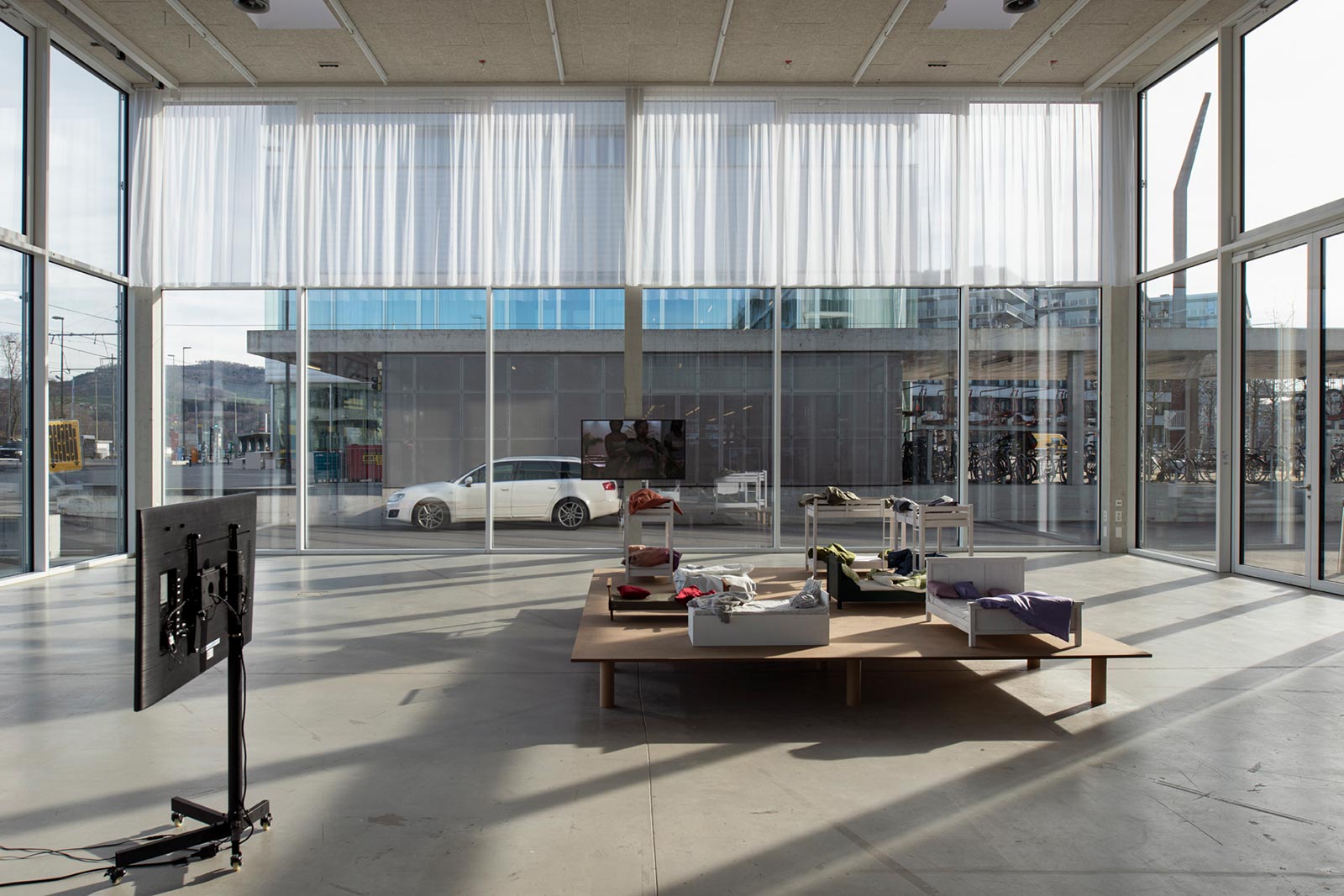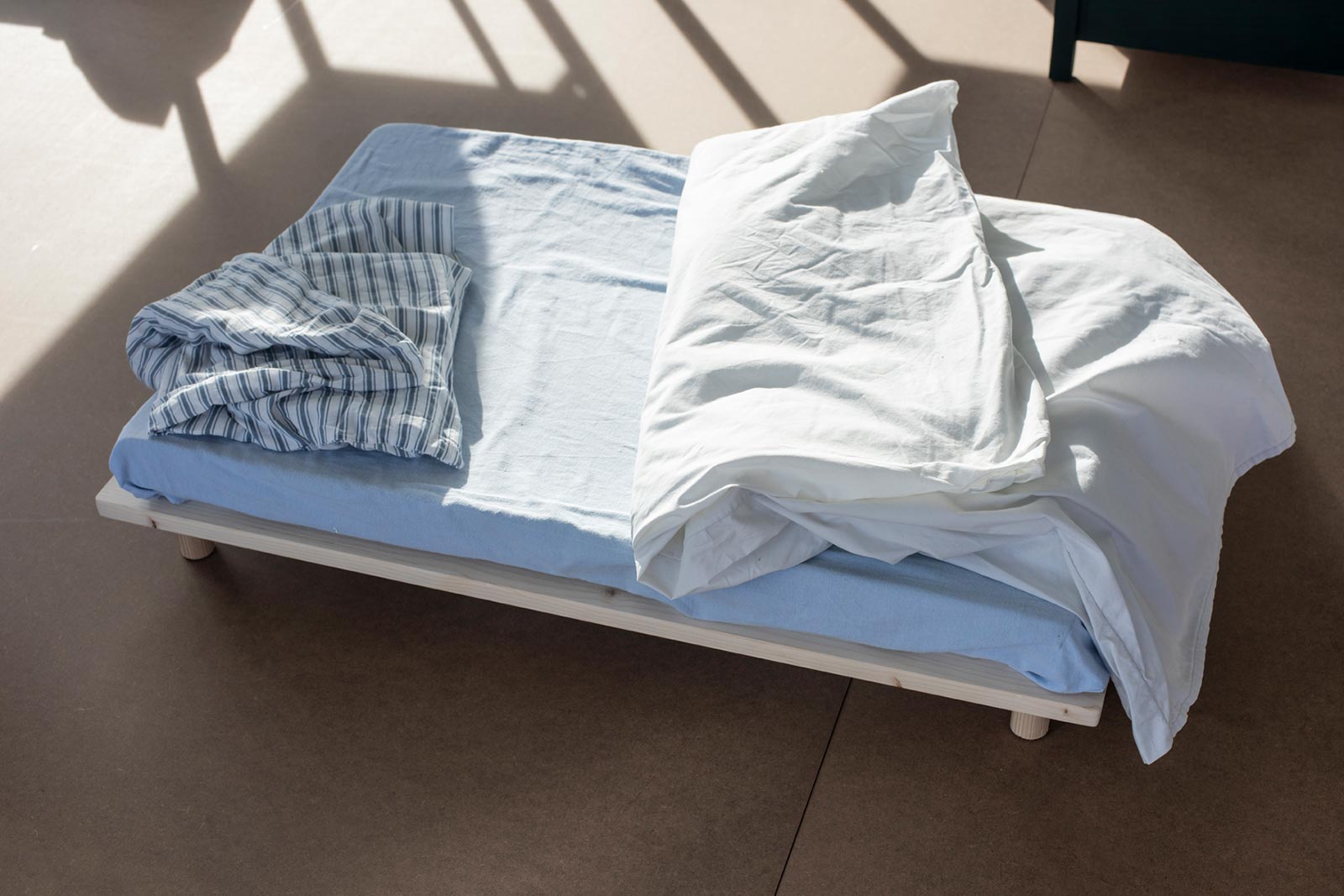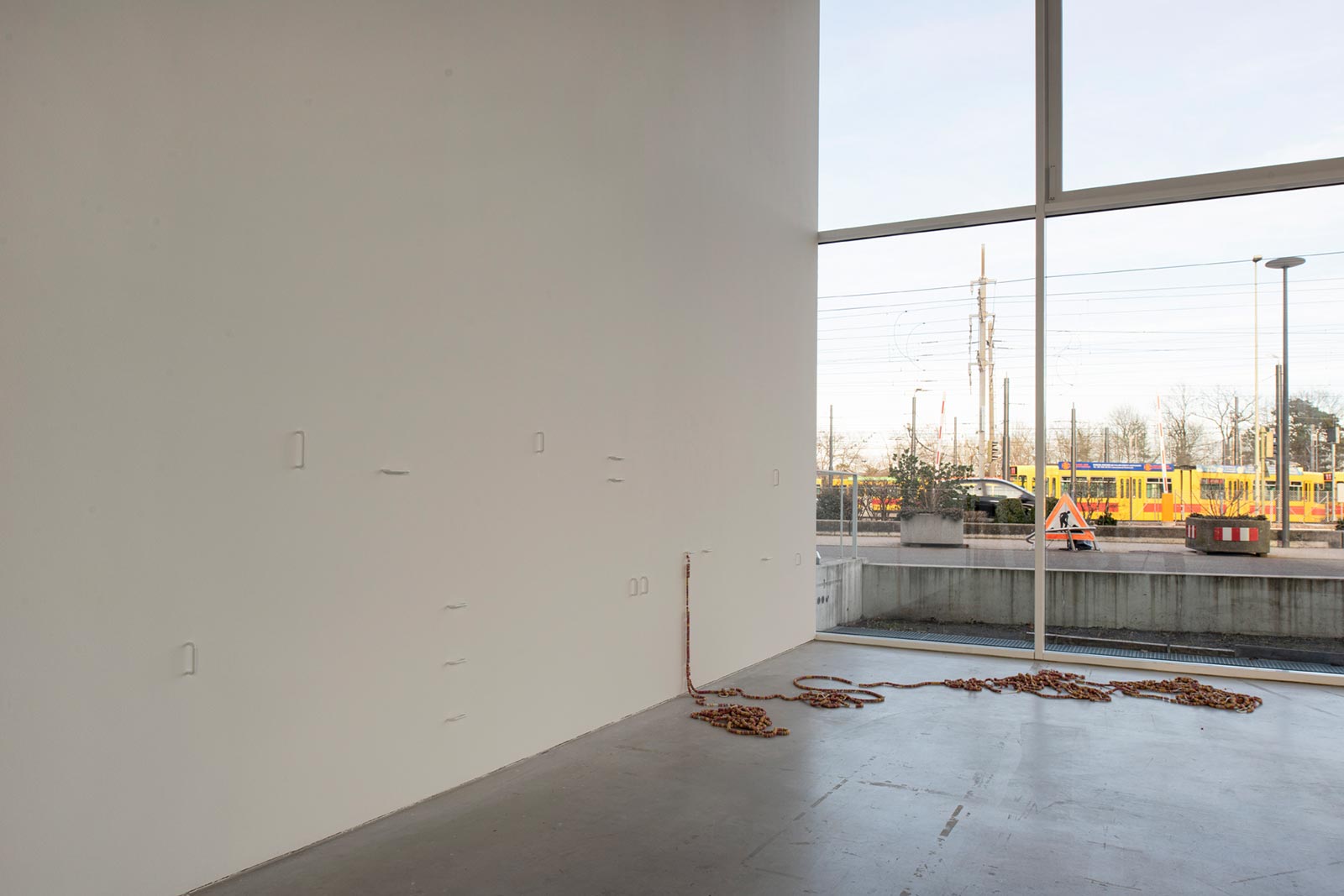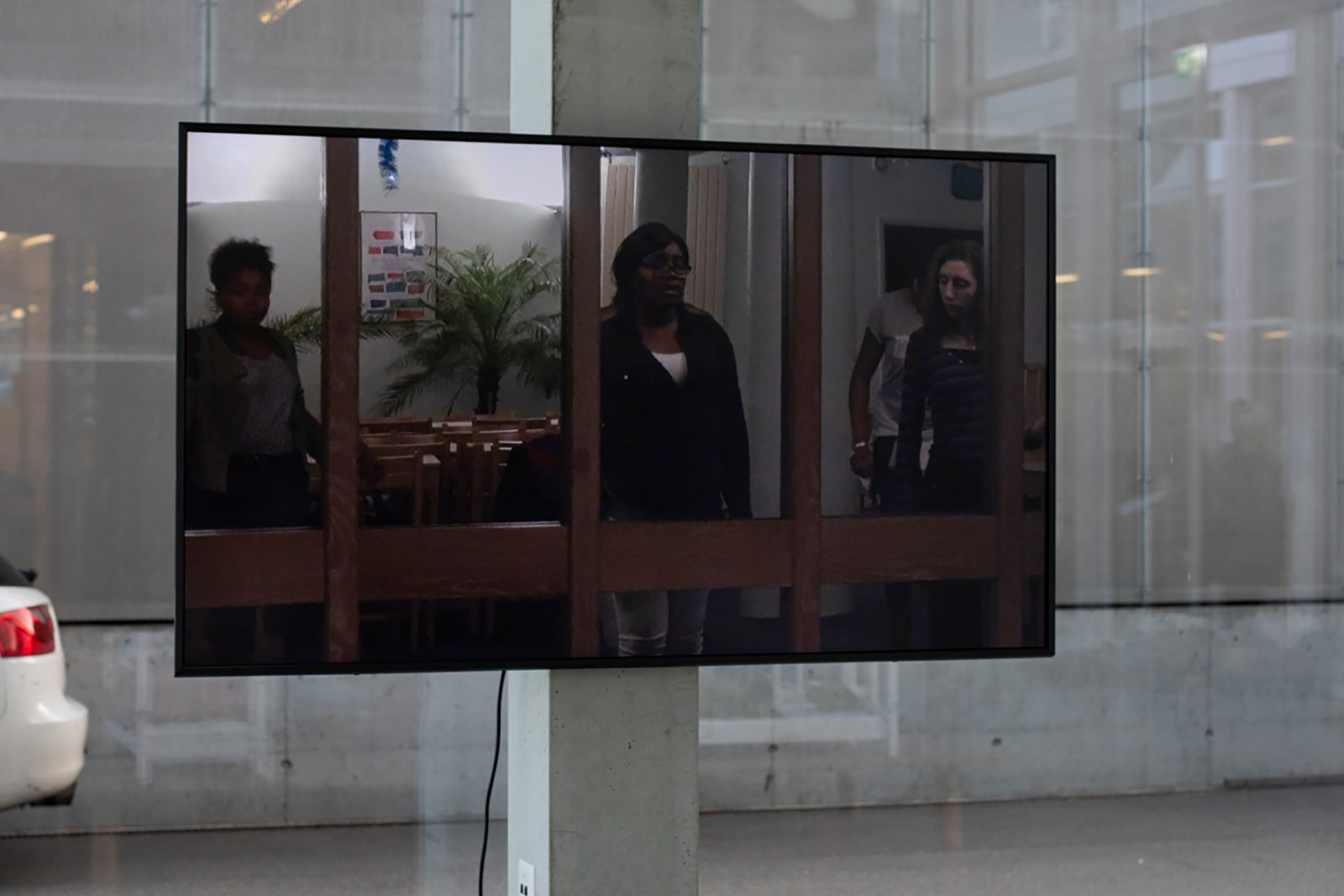The Commissions
Tiphanie Kim Mall
Mia Sanchez
Valentina Stieger
Our Common Space
Kuratiert von Roman Kurzmeyer
Vernissage Freitag 21. Februar 2020, 18:00 – 20:00
Anschliessend Filmvorführung Echo der Zeit (2017 – 2020) von Tiphanie Kim Mall im Studiokino D 0.01 (Hochhaus)
Ausstellung 22. Februar – 1. März 2020
Öffnungszeiten: Samstag und Sonntag, 14:00 – 18:00
Und nach Vereinbarung: dertank.hgk@fhnw.ch
«Such is the manner of our seeing»
Unsere Lebenswelt, mit dem persönlichen Bereich als Zentrum, ist der gemeinsame Ausgangspunkt für Tiphanie Kim Mall, Mia Sanchez und Valentina Stieger. Our Common Space ist eine Ausstellung, welche die Arbeiten der drei Künstlerinnen so zeigt, dass die Kunstwerke im Zusammenspiel erfahrbar werden und zu erzählen beginnen. Nicht nur vom konkreten Ort, dem verglasten Ausstellungsraum, den sie sich teilen, sondern vor allem von der Wahrnehmung der Welt ausserhalb der Vitrine und dem der Kunst und dem Design vorbehaltenen Campus der Künste. Der polnische Architekt und Künstler Oskar Hansen (1922 – 2005) beschrieb die Aufgabe der Kunst als «das Formen von Raum mittels visueller Strukturen, also nicht um anzuschauen, sondern um zu sehen. Um das Wichtigste im Raum zu sehen – den Menschen, der so schwer zu erkennen, zu unterscheiden ist im Chaos des mit Gegenständen zugeschütteten, zugemüllten Raums der Closed Form, von dem wir heute umgeben sind.» Die Arbeiten im TANK lenken den Blick in unterschiedlicher Weise und Intensität auf den Menschen, etwa indem sie unseren Lebensraum, dessen Gestaltung und Organisation sowie die Auswirkungen auf das Menschenbild unserer Gesellschaft thematisieren, Menschen in ihrem Alltag zeigen oder sie über die Darstellung ihrer Abwesenheit vergegenwärtigen.
Tiphanie Kim Mall richtet die Kamera schonungslos und neugierig auf sich selbst, ihr persönliches Umfeld oder auf Menschen im öffentlichen Raum, die sich unbeobachtet glauben. Der Film Echo der Zeit (2017 – 2020) ist ein intimes Porträt ihrer Familie, die sich im Hochsommer im Landhaus der verstorbenen Grossmutter versammelt. Der Film handelt von unbefangener Nähe zu Eltern und Geschwistern, aber auch von den Verstrickungen der Familienmitglieder untereinander und erzählt in dichten, schnellen Bildern aus dem Alltag einer wohlhabenden, einst matriarchal geprägten Grossfamilie. Die Familie selbst ist an der ungewöhnlichen Kameraführung beteiligt. Das Video Val d’Europe (2014 – 2020) zeigt betagte Menschen, die sich langsam und ziellos in anonymen, überdimensionierten Hallen von Einkaufszentren bewegen. In der Schulkantine einer Pariser Gewerbeschule, an der die Künstlerin als Aufsicht arbeitete, entstand Surveillante (2016). Zu sehen ist in verlangsamten, stummen Bildern eine Gruppe von Mädchen, die ein Tanzstück erarbeiten und nach einer eigenen Choreografie tanzen. Für ihr neuestes Video, Gynäkologin (2020), lässt sich Tiphanie Kim Mall von ihrer Mutter zu einem Arzttermin begleiten und überlässt ihr während der Behandlung die Kamera. Die Bilder sind verstörend, da die Künstlerin für diese intime Situation, die sie in Bild und Ton widergibt, keine fiktionalisierte Form wählte.
Mia Sanchez dagegen bespielt den Raum mit Requisiten, die eine Wirklichkeit vor Augen führen, die nur der Vorstellung zugänglich ist. Die auf einer grossen Bühne präsentierten, von ihr in Handarbeit hergestellten Verkleinerungen von Betten geben keinen Hinweis darauf, für wen sie bestimmt waren. Jedes Bett ist individuell bezogen, alle sind ungemacht. Zu sehen sind zurückgeschlagene Decken und zerknautschte Kissen. Man meint die Wärme der Körper noch zu spüren und weiss, dass es sich um Zeichen handelt. Die Betten sind keine Schlafstellen sondern Artefakte, die wie Fotografien Erinnerungen auslösen oder Vorstellungen hervorrufen. Wiederholung, Skalierung und Modifikation spielen bei Sanchez sowohl in formaler Hinsicht als auch als Motiv eine zentrale Rolle, sie sind auch im Schaffen der beiden anderen Künstlerinnen als künstlerische Prinzipien erkennbar. Mia Sanchez entwickelt Installationen, die wie jene von Valentina Stieger zugleich Display und Werk sind, befasst sich aber nicht wie diese mit der materiellen Kultur und dem Erbe des Modernismus, sondern versteht ihre Arbeit als Entwurf einer Topografie des Sehens. Sie untersucht Fragen der Perspektivität und Übersetzung. In ihren Ausstellungen erinnert Mia Sanchez an den Unterschied zwischen ästhetischer und alltäglicher Wahrnehmung und an jenen zwischen Bild und Wirklichkeit. Sie arbeitet an deren Schnittstellen und steht mit ihren Trugbildern in einer Tradition, die bis zu René Magritte zurückführt. Das Kunstwerk ist für sie die Fiktion einer Fiktion.
Valentina Stieger beschäftigt die Ökonomisierung der (privaten) Lebenswelt und die Frage, welche Rolle das «Design» in diesem Prozess spielt. Sie untersucht den Zusammenhang von Industrialisierung, Rationalisierung und Normierung. Im TANK zeigt sie drei Arbeiten.Einen weissen Tagesvorhang an einer der Glasfronten nennt sie Decoration Looks Ahead (Sheer Polyester (2020). Es handelt sich um eine Arbeit, die sie seit 2012 als ortsspezifische Serie in unterschiedlichen Kontexten zeigt. Für die Herstellung wurde wie bei früheren Versionen ein handelsüblicher Stoff verwendet, der in Rollen von drei Metern Breite angeboten wird, geeignet für die heute im Wohnungsbau üblichen Raumhöhen. Der Vorhang hängt einerseits zu hoch, um seine Funktion als Sichtschutz zu erfüllen, andererseits evoziert er ein Geschoss, das im Ausstellungsraum nicht vorhanden, an der Fassadenkonstruktion jedoch ablesbar ist. Auch Seven Days A Week (2020) erzählt vom Siegeszug des modularen Bauens und des Funktionalismus, die sich längst in unsere Körper eingeschrieben und jeden Lebensbereich, insbesondere auch die Ernährung, verändert haben. Die Anordnung der auf die Wand montierten ergonomischen Handgriffe orientiert sich an Masseinheiten, die heute im Küchenbau üblich sind. An der Küche, deren Stellenwert und Funktion sich in unserem häuslichen Alltag nur langsam verändern, werden Geschlechterrollen sichtbar und deren Neuregelung ablesbar. Die Wandarbeit dient zugleich als Display für Flavour Of The Month (2020), an einem Seil aufgereihte Froot Loops von Kellogg’s in Regenbogenfarben. Die Farbpalette dieser industriell hergestellten Getreideringe wurde im Lauf der Jahrzehnte verändert und erweitert, zuletzt um Rosa, Gelb und Lila, möglicherweise als Reaktion der Nahrungsmittelindustrie auf die Genderdebatte. Valentina Stieger nähert sich den Dingen mit einer an Minimalismus und Konzeptualismus geschulten künstlerischen Methode, inhaltlich aber beschäftigt sie sich mit Fragen der Produktion von Wirklichkeit und Identität.
Die ausgestellten Arbeiten der drei Künstlerinnen bilden einen visuellen Erfahrungsraum, in dem sich Privates und Gemeinschaftliches gegenseitig spiegeln. Das einleitende Zitat übrigens, «Such is the manner of our seeing» stammt aus dem experimentellen Roman Jacob’s Room von Virginia Woolf aus dem Jahre 1922.
Roman Kurzmeyer
Tiphanie Kim Mall wurde 1987 in Basel geboren und lebt zurzeit in Berlin. Sie studierte zunächst Fotografie an der Ecole cantonale d’art de Lausanne ECAL. Ihr Studium der Kunst am Institut Kunst HGK FHNW in Basel schloss sie 2019 mit einem Master in Fine Arts ab. 2018 stellte sie zusammen mit Flora Klein im Treize, Paris, aus. Anfang 2020 war eine ihrer Arbeiten in der Gruppenausstellung Le complexe de Rivoli in der Galerie DuflonRacz in Brüssel zu sehen.
Mia Sanchez wurde 1988 in Sevilla geboren und lebt in Basel. Sie studierte an der Hochschule der Künste Bern HKB, der Hochschule für Bildende Kunst Hamburg HfBK und am Institut Kunst HGK FHNW in Basel, wo sie 2019 den Master in Fine Arts erwarb. 2018 wurde sie mit dem Kiefer Hablitzel / Göhner Kunstpreis ausgezeichnet. Zusammen mit Andreas Kalbermatter und Dominic Michel gründete sie 2015 den Kunstraum Riverside in Bern-Worblaufen. Zuletzt zeigte die Stadtgalerie Bern 2019 ihre Einzelausstellung Truths, Scoops, Consequences.
riverside-space.ch
Valentina Stieger wurde 1980 in St. Gallen geboren und lebt in Zürich. Sie studierte am Institut Kunst HGK FHNW in Basel und an der Zürcher Hochschule der Künste in Zürich ZHdK, wo sie 2013 einen Master of Arts in Fine Arts erwarb. Neben Einzelausstellungen wie Simple Harmony Triumphs Again in der Galerie Stampa in Basel (2017) und Indoor Life in der Kunsthalle St. Gallen (2018), war sie an zahlreichen Gruppenausstellungen beteiligt. Der Kanton Zürich sprach ihr das Atelierstipendium Berlin für 2020 zu.
valentinastieger.com
Die Ausstellung Our Common Space ist nach Louise Guerra Archive: Keine richtige Schule (2019), Kaspar Müller: Rendering of service in the pitch of the bruise (2019), Jürg Stäuble & Hannah Villiger (2018), Kasia Klimpel – Berge (2018) und Werner von Mutzenbecher – 8/1/D999R (2017) das sechste Projekt in einer 2017 begonnenen Reihe mit Arbeiten von Alumni des Institut Kunst.
The Commissions
Tiphanie Kim Mall
Mia Sanchez
Valentina Stieger
our common space
Curated by Roman Kurzmeyer
Opening Friday 21 February 2020, 6 – 8 pm
Followed by film screening Echo der Zeit (2017 – 2020) by Tiphanie
Kim Mall, Studio Cinema D 0.01 (Tower Building)
Exhibition 22 February – 1 March 2020
Opening hours: Saturdays and Sundays, 2 – 6 pm
And by appointment: dertank.hgk@fhnw.ch
“Such is the manner of our seeing”
The world we live in now, with privacy at its core, forms a common point of departure for Tiphanie Kim Mall, Mia Sanchez and Valentina Stieger. The exhibition Our Common Space displays the three artists’ works in a way that they can be experienced in their interplay and synergy to tell a story. Not just a story of the venue itself—the glass-fronted exhibition space they are sharing—but moreover one perceived in a world beyond the display case and the Campus of the Arts, dedicated to art and design. The Polish architect and artist Oskar Hansen (1922 – 2005) described the purpose of art as “the shaping of space by means of visual structures, not only to be looked at (or viewed), but also to see. To see the most important thing in space—the human being, who is so difficult to make out, to distinguish from the chaos of the object-littered, object-cluttered space of Closed Form that surrounds us today.” In various ways and degrees of intensity, the works at der TANK direct our attention to the human. They explore the environment we live in, its design and organization, as well as its impact on the concept of humanity within our society. They show people in their routine of everyday life or visualize them by depicting their absence.
Tiphanie Kim Mall relentlessly and inquisitively focuses the camera on herself, her personal surroundings or on people in public spaces, who believe they are unobserved. The film Echo der Zeit (2017 – 2020) is an intimate portrait of her family as they congregate in the country house of her deceased grandmother in midsummer. The film explores the uninhibited intimacy of parents and siblings, but also of the family members’ entangled relationships with each other. The dense fast-paced images convey the everyday life of a large and wealthy, once matriarchal family. The family itself participates in the unconventional camerawork. The video Val d’Europe (2014 – 2020) portrays elderly people while they wander slowly and aimlessly through the anonymous, oversized halls of shopping malls. Surveillante (2016) was filmed in the canteen of a vocational school in Paris, where the artist worked as a supervisor. In decelerated, muted images, we see a group of girls practicing a dance piece and dancing to their own choreography. In her most recent video, Gynäkologin (2020), Tiphanie Kim Mall has her mother accompany her to a doctor’s appointment. During the procedure, she hands her the camera. The images are disturbing, since the artist has decided against a fictionalized form for this intimate situation, which she depicts in both sound and image.
Mia Sanchez, on the other hand, activates the exhibition space with props that reveal a reality only accessible through imagination. The miniature beds are hand-made by the artist and presented on a large stage. There is no indication for whom they were intended. Each bed is unmade and has its own individual bedding. We see folded back duvets and crumpled pillows. We can imagine to still feel the bodies’ warmth and yet we know these are signs. The beds are not places of rest but artefacts, which, much like photographs, can trigger memories or evoke ideas. Repetition, scale and modification play a central role in Sanchez's work, both formally as well as thematically. They can also be identified as artistic principles in both the other artists’ work. Mia Sanchez creates installations which, like those of Valentina Stieger, are display and artwork at the same time. Unlike Stieger, however, she doesn’t concern herself with material culture and the legacy of Modernism, but considers her work as a proposed topography of seeing. She explores questions of perspectivity and translation. In her exhibitions, Mia Sanchez reminds us of the difference between aesthetic and everyday perception, and the difference between image and reality. She works at these interfaces while her illusions make her part of a tradition that goes back to René Magritte. For her the work of art is a fiction of a fiction.
Valentina Stieger investigates the economization of the (private) world and the role of «design» in this process. She examines the connection between industrialization, rationalization and standardization in the three works at der TANK. The white day curtain running along one of the glass fronts is entitled Decoration Looks Ahead (Sheer Polyester) (2020). This work is a site-specific series that has been shown in various contexts since 2012. As in previous versions, a commercial fabric sold in three-meter wide bolts—suitable for room height typical of today’s home—has been employed.On the one hand, the curtain hangs too high to function as a privacy screen. On the other hand, it evokes another floor which does not exist in the exhibition space, but can be deduced from the construction of the facade. Seven Days A Week (2020) also recounts the triumph of modular construction and functionalism, which have long since become ingrained in our bodies and have changed every aspect of life, especially nutrition. The arrangement of the ergonomic handles mounted on the wall is based on dimensions that are commonly used in the design of today’s kitchens. In the kitchen, and its very slowly evolving status and function in our everyday lives at home, gender roles and their redefinitions become visible. The wall piece also serves as a display for Flavour Of The Month (2020), a series of rainbow-colored Kellogg's Froot Loops strung on a rope. The color palette of these factory-made cereal rings has changed and expanded over the decades. Most recently featured are pink, yellow and purple—possibly a response of the food industry to the gender debate. Valentina Stieger’s approach is trained in the artistic methods of minimalism and conceptualism. In terms of content, however, she addresses questions concerning the production of reality and identity.
The exhibited works of the three artists create a visual space of experience in which the private and collective reflect each other. The introductory quote "Such is the manner of our seeing" is from Virginia Woolf's experimental novel Jacob's Room (1922).
Roman Kurzmeyer
Tiphanie Kim Mall was born in Basel in 1987 and currently lives in Berlin. She studied photography at the Ecole cantonale d'art de Lausanne ECAL and completed her studies at the Art Institute HGK FHNW in Basel in 2019 with a Master in Fine Arts. In 2018 she was part of a duo show with Flora Klein at Treize, Paris. At the beginning of 2020, she showed a work in the group exhibition Le complexe de Rivoli at the Galerie DuflonRacz in Brussels.
Mia Sanchez was born in Seville in 1988 and lives in Basel. She studied at the Hochschule der Künste Bern HKB, the Hochschule für Bildende Kunst Hamburg HfBK and at the Art Institute HGK FHNW in Basel, where she graduated with a Master in Fine Arts in 2019. In 2018 she was awarded the Kiefer Hablitzel / Göhner Kunstpreis. Together with Andreas Kalbermatter and Dominic Michel she founded the art space Riverside in Bern-Worblaufen in 2015. Most recently, the Stadtgalerie Bern presented her solo exhibition Truths, Scoops, Consequences in 2019
riverside-space.ch
Valentina Stieger was born in 1980 in St. Gallen and lives in Zurich. She studied at the Art Institute HGK FHNW in Basel and at the Zurich University of the Arts ZHdK, where she graduated with a Master in Fine Arts in 2013. Aside from solo exhibitions such as Simple Harmony Triumphs Again at Galerie Stampa in Basel (2017) and Indoor Lifeat Kunsthalle St. Gallen (2018), she has participated in numerous group exhibitions. The Canton of Zurich has awarded her with a studio grant in Berlin for 2020.
valentinastieger.com
The exhibition Our Common Space is the sixth of a series of exhibitions initiated in 2017 that presents commissions of former students and lecturers of the Art Institute. Previous exhibitions include Louise Guerra Archive: Keine richtige Schule (2019), Kaspar Müller: Rendering of service in the pitch of the bruise (2019), Jürg Stäuble & Hannah Villiger (2018), Kasia Klimpel – Berge (2018) and Werner von Mutzenbecher – 8/1/D999R (2017).



